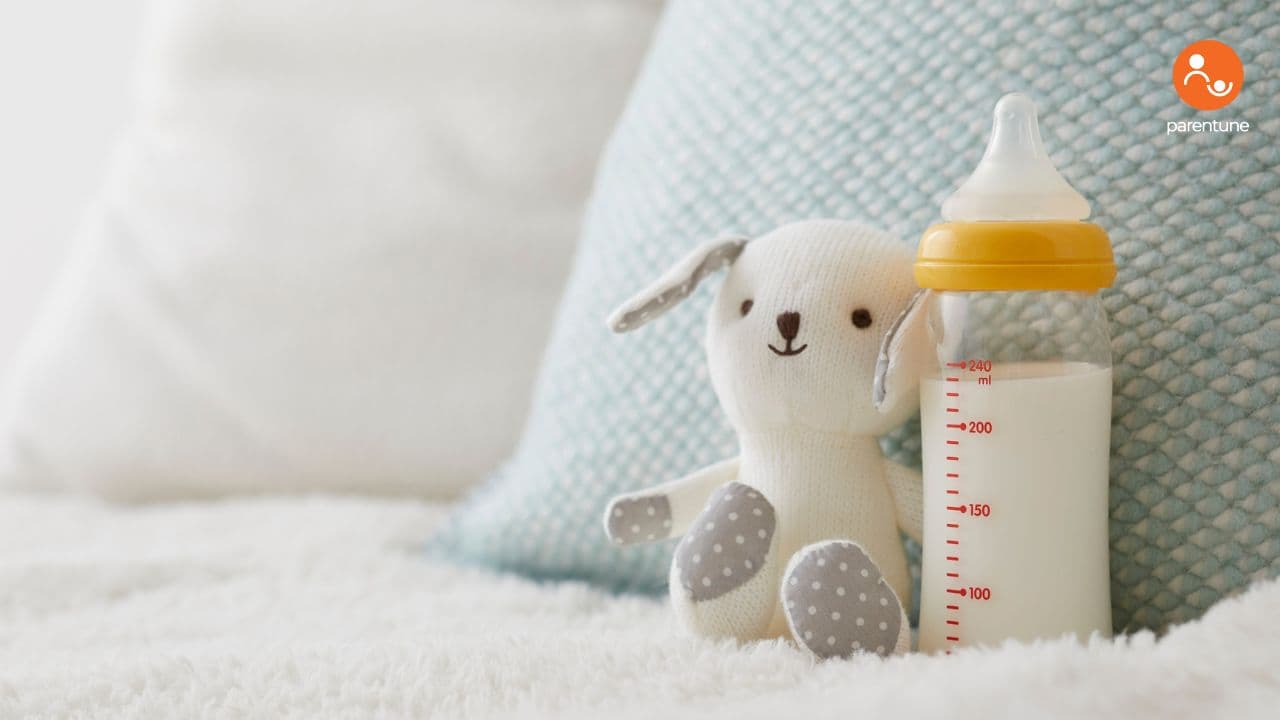daily-tips
How To Bottle Feed A Newborn: A Step-By-Step Guide For The First-Time Parent

Published: 22/07/25
Updated: 22/07/25
Welcome to parenthood.
Bottle feeding isn’t just about holding a bottle to your baby’s lips. It’s a dance—of timing, technique, and trust. Done right, it builds more than nutrition. It builds connection.
Let’s decode what actually works.
Why Some Parents Choose To Bottle Feed
Because real life is messy.
Some moms can't breastfeed. Some choose not to. Some mix both. And some switch later.
Doctor Q&As from Parents like you
All valid. All loving.
At Parentune, we’ve seen hundreds of real-life feeding journeys. Single parents. Working moms. NICU graduates. Each story is different, but one thread is common—they want to do what’s best for their baby.
Bottle feeding, when done with care, is just that.
Before the First Feed: What Needs to Be in Place
The best feeding moment starts before the bottle even touches your baby’s lips.
Here’s what to have ready:
1. Bottles and Nipples That Match Your Baby’s Stage
-
Newborn-friendly nipples: Slow-flow is key. Too fast and they’ll gulp; too slow and they’ll tire out.
-
Wide-neck bottles: Easier to clean. Mimics breastfeeding latch.
2. Sterilization System
Boiling, electric sterilizer, or microwave bags—pick one. Clean bottles aren’t optional.
3. Formula or Expressed Breast Milk (EBM)
-
Follow formula mixing instructions exactly—the water-to-powder ratio affects digestion.
-
If using EBM, warm it gently in a water bath. Never microwave.
The Feeding Setup: Create A Calm Space
Feeding is not just physical—it’s emotional.
Dim lights. Minimal noise. Your undivided attention.
This isn’t just about feeding. It’s about bonding. Your baby feels your calm—or your stress.
How to Bottle Feed: The Exact Steps That Matter
Let’s walk through the real steps. Not the Pinterest-perfect version—the one that works at 2AM.
Step 1: Wash Your Hands
Seems obvious. Gets skipped more often than we’d like to admit.
Step 2: Warm the Milk (If Needed)
Breast milk or formula should be body temperature—around 37°C. A wrist test works: drop a bit on the inside of your wrist. It should feel neutral.
Step 3: Hold Your Baby Upright, Supported
-
Head above stomach—this helps prevent reflux.
-
Rest their head in the crook of your arm. Support their neck.
Pro tip: Switch arms mid-feed to balance muscle development.
Step 4: Tilt the Bottle, Watch the Flow
-
Keep the nipple full of milk to avoid swallowed air.
-
Angle the bottle about 45 degrees.
If bubbles rise in the bottle, you’re holding it right.
Step 5: Let Baby Set the Pace
Newborns suck in rhythms. Pause. Breathe. Suck again.
Don’t force a finish. Babies know when they’re done.
Burping Isn’t A Bonus—It’s Non-Negotiable
Air bubbles happen. So do cranky cries if they’re not burped out.
Try these methods:
-
Over-the-shoulder with gentle back pats
-
Sitting baby upright on your lap, chin supported
-
Lying baby face-down across your lap, gently patting their back
If nothing comes out in 5–10 minutes? That’s okay too.
How Often And How Much Should You Bottle Feed?
Short answer: It depends. Long answer: Let’s break it down.
General Guidelines (Newborn Stage):
-
Every 2–3 hours, or 8–12 feeds a day
-
60–90 ml per feed during the first few weeks
But babies aren’t machines. Growth spurts change hunger patterns. So does the weather. So does sleep.
Watch for hunger cues:
-
Rooting (turning head toward touch)
-
Sucking on fingers
-
Whimpering or smacking lips
Crying is a late hunger cue.
What If My Baby Refuses The Bottle?
Welcome to one of the most common challenges.
Here’s what usually helps:
-
Try a different nipple flow: Sometimes it’s too slow or too fast.
-
Change the bottle brand: Babies have preferences. Seriously.
-
Offer when calm, not starving: Hunger makes them frustrated.
-
Let someone else try: If they associate you with breastfeeding, a partner might have more luck.
Still stuck? The Parentune community has thread after thread of parent-tested hacks. It’s like a WhatsApp group of 100K+ moms who’ve been there.
Night Feeds: Surviving The Sleep-Deprived Shift
It’s not glamorous. But it’s manageable.
-
Pre-mix formula powder into bottles (no water) before sleeping
-
Use a thermos of warm water at bedside to mix quickly
-
Keep a dim nightlight on—just enough to see, not stimulate
Sleep and feeding don’t have to be enemies. Just optimize for one-handed moves.
Signs You’re Doing It Right
-
Baby is gaining weight steadily
-
Wet diapers: 6–8 a day
-
Baby seems relaxed post-feed
-
Minimal spit-ups or colic episodes
Trust your instincts—but pair them with real data. Apps like Parentune’s growth tracker help you track the metrics without obsessing.
Common Mistakes First-Time Parents Make (And How To Avoid Them)
-
Overfeeding: More isn’t always better. Cue-based feeding wins.
-
Using the wrong nipple size: Causes choking or frustration.
-
Skipping burps: Leads to unnecessary gas and tears.
-
Letting milk sit too long: Formula is good for 1 hour once prepared.
Every mistake is a lesson, not a failure.
What This Teaches Us About Parenting
Bottle feeding is a microcosm of parenthood.
You prepare, adapt, observe, and adjust. You listen without words. You build trust drop by drop.
It’s not just about the bottle.
It’s about learning to read the cues, build the rhythm, and meet your child where they are.
That’s the real feed.
Parentune: Your Companion Through the Chaos
Thousands of parents trust Parentune to decode baby sleep, feeding, growth, and behavior—with expert advice and peer stories that feel like home.
Because sometimes, what you really need isn’t just information.
It’s reassurance that you’re not alone.
Be the first to support
Be the first to share
Related Blogs & Vlogs
No related events found.